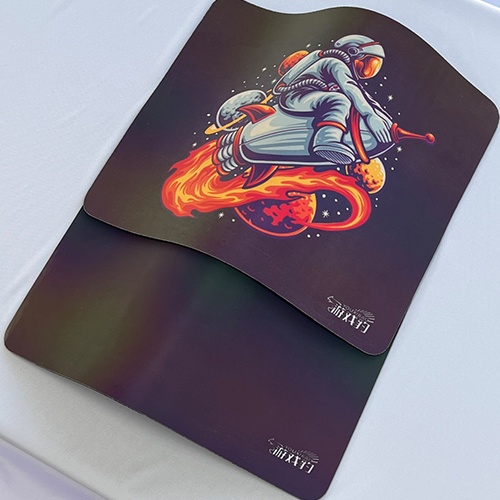When selecting a mouse pad, understanding the material differences can significantly impact your overall user experience. Here’s a detailed look at the various types of mouse pad materials and their unique characteristics:Even so, gaming mouse pad manufacturer We must also adhere to the quality of the industry and create unique products for the company. https://fldrubber.com
1. Fabric Mouse Pads
Fabric Material: Most commonly, fabric mouse pads are made from Jacquard fabric. Jacquard fabric is a type of knitted material known for its excellent drape, safety, and comfort. It is widely used in various applications, including bags, gaming mouse pads, calendars, and art prints. Additionally, it’s used in high-performance fabrics such as wetsuits, sports knee pads, cycling apparel, and mountaineering gear due to its waterproof and breathable properties.
Impact on Use: The texture of the fabric, including its thickness and weave density, significantly influences the mouse pad’s feel. Generally, finer fabrics with a dense weave provide a smoother and more refined experience, while thicker fabrics with a coarser weave offer a rougher, more textured feel. Matching the mouse pad material with the size and material of your mouse feet is crucial for a balanced experience.
2. Coated Mouse Pads
Coated Material: Coated mouse pads are essentially a subtype of fabric pads. As the name suggests, these pads feature an additional coating on top of the fabric, designed to enhance smoothness during use. The QPAD CT series is considered a pioneer in this category. Although coated pads provide a superior, silky feel, they tend to be more expensive, prone to wear, and less durable. They cannot be folded without risking damage to the coating.
Color vs. Non-Color: It’s worth noting that mouse pads with color often feel smoother compared to their non-colored counterparts. For instance, the ZOWIE GSR-DIVINA-SE feels slicker than the standard GSR. This difference is attributed to the so-called “micro-coating” layer, where the coating is so thin that it might be almost imperceptible when worn down. Some mouse pads manufacturers use inks in place of coatings during heat transfer printing, impacting the final texture.
3. Resin and Metal Mouse Pads
Resin Mouse Pads: Resin mouse pads come in both fine and coarse surfaces, with some models offering dual-sided use, like the RAzer Vespula. Compared to fabric pads, resin pads provide a smoother glide and are favored by users who prefer harder surfaces. However, resin pads are prone to rapid surface wear with intense use and may require regular cleaning if exposed to sweat. They can also cause significant wear on mouse feet.
Metal Mouse Pads: Metal mouse pads are similar to resin pads but offer superior durability. They are known for their cool touch in summer but can be quite cold in winter. For example, aluminum mouse pads are popular but tend to be smaller in size. They can produce loud noises with mouse movements and may cause accelerated wear on mouse feet. Long-term use may also lead to metal surface corrosion.
The choice between fabric, coated, resin, and metal mouse pads depends on your personal preferences, budget, and usage requirements. Each material offers distinct advantages and drawbacks, impacting comfort, durability, and overall performance. Consider these factors carefully to find the ideal mouse pad for your needs.